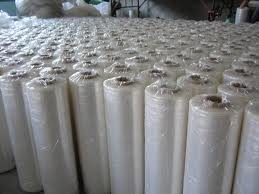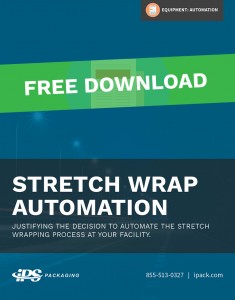
stretWhen it comes to improving efficiencies on the packaging line, one of the ways to help improve quality while decreasing material usage and increasing labor savings is to improve stretch wrapping efficiencies. As sustainability also continues to maintain traction, looking at sustainability through packaging line efficiencies can help to improve the impact across the supply chain.
 More than 1.9 billion pounds of petroleum-based resins are consumed in the manufacture of stretch film for the US alone.
More than 1.9 billion pounds of petroleum-based resins are consumed in the manufacture of stretch film for the US alone.For example, reducing stretch film consumption is essential for improving the sustainability of transporting pallet loads, as well as lowing costs on the packaging line. On average, US based companies spend billions of dollars on stretch film. More than 1.9 billion pounds of petroleum-based resins are consumed in the manufacture of stretch film for the US market alone, and with the fluctuating costs of a barrel of oil, companies must effectively reduce usage of all petroleum-based materials, including stretch film, to contain costs.
But, consider this: advances in chemistry and enhanced products, processes, and services have allowed manufacturers to down-gauge stretch film by more than 25% in the last decade, potentially saving - on a global basis - one billion pounds of polyethylene resin a year. This is the equivalent energy savings of 293 million gallons of gasoline or heating and cooling for 643,000 homes for one year.
Suddenly, stretch film is starting to look far more important than you might have initially thought.
Application Techniques
Stretch film is a highly engineered material, designed to be pre-stretched within a specified range (usually between 200 and 300%) in order to bring out the material’s maximum strength characteristics.
 If you are wrapping 15+ loads per day, it’s more cost-effective to use a machine than to wrap by hand.
If you are wrapping 15+ loads per day, it’s more cost-effective to use a machine than to wrap by hand.There are two ways to apply stretch wrap, by hand and by machine. Hand wrapping is labor intensive, slow, and cannot effectively stretch the film greater than 20% on average; this has negative consequences on holding strength and unit stabilization. To increase stabilization, personnel often over-wrap the pallet, using far more material than is necessary. At the same time, workers are prone to injuries from tripping, falls, and repetitive motion, as they round the pallet.
Stretch wrap machines are the preferred means of obtaining high performance from the material and eliminating the negatives of hand wrapping. The more the material is stretched, the lower the usage and the greater the savings. Other advantages include lower labor costs, greater load stabilization, and less damage to pallet loads during transportation. Stretch wrap machines are typically justified on a return-on-investment basis by calculating both material and labor savings.
For example, companies A, B, and C wrap identical pallet loads per day using the same type of stretch film that costs $45 per roll. Company A’s machine achieves 25 percent stretch while Company B achieves 150 percent stretch, and Company C achieves 250 percent stretch. At 25% stretch, Company A is spending $42,712 to wrap 250 pallets a day. By comparison, Company C (achieving 250% stretch) is only spending $16,575 to wrap 250 pallets a day.
Material savings add up quickly and justify the investment in a high performance pallet wrapping machine. In terms of improving the sustainability of the operation, Company C at 250 percent stretch and 500 pallets a day will consume about 1,135 fewer rolls than Company A and 285 fewer rolls than Company B on an annual basis. Company C not only lowers operating costs, it improves the sustainability of its end-of-line packaging operation. The reason is that Company C decreases the number of deliveries of rolls of film into its plant over the other two companies and the also the weight of every pallet leaving the plant. These efficiencies in transportation will result in reduced energy consumption and carbon dioxide emissions.
Load Stabilization Considerations
To achieve ideal 250% stretch, the film must undergo powered pre-stretch before the film is wrapped around the pallet. The stretch wrapper’s film carriage uses an electric motor to turn two rollers, each rotating at different speeds which stretches the film before it is applied.
As the stretch wrap machine applies film over sides and corners of pallet loads, payout speed must constantly change for uniform hold strength and unit stabilization. The reason for this is that the film must be played out faster around a corner. The film carriage’s response time at corners should be virtually instantaneous or the lag in speed-up will increase the drag on the film and promote tearing. Operations personnel may compensate for frequent tears by buying higher gauge wrap, which costs more and wastes material. They do not understand that the root cause of the problem is not the thickness of the film but in the application around corners. Specify a machine with state-of-the-art corner compensation/motion control technology. Operations personnel will find they can actually use a thinner gauge film with this equipment.
 Also look for advanced force-to-load control. Heavier, more rugged pallet loads, for example manufactured concrete products, require more force to load than lighter and more easily crushed loads, PET bottles for example. The pallet wrapping machine must have easy-to-use and automatic force-to-load settings. Power pre-stretch, corner compensation, and force-to-load settings all impact the consistency and quality of the stretch wrapping process. These capabilities on high performance machines also mean operations personnel will be able to use the lightest weight material for the application and improve sustainability.
Also look for advanced force-to-load control. Heavier, more rugged pallet loads, for example manufactured concrete products, require more force to load than lighter and more easily crushed loads, PET bottles for example. The pallet wrapping machine must have easy-to-use and automatic force-to-load settings. Power pre-stretch, corner compensation, and force-to-load settings all impact the consistency and quality of the stretch wrapping process. These capabilities on high performance machines also mean operations personnel will be able to use the lightest weight material for the application and improve sustainability.
While recovery and reuse of material is preferable, recycling stretch film for most companies is not economically feasible. The more effective means of conservation of this material is to use less by stretching the film at least by today’s performance standard of 250 to 300 percent. Knowing what to look for in stretch films and advanced pallet wrapping machines helps ensure improvements in sustainability — economic, social, and environmental.
Learning How It Affects Your Business
Stretch wrapping efficiencies can help save you time, money, material, and resources. To learn more, visit our #packagingKnowledge website on Stretch Wrap or download our eBook. And when you've done that, reach out and let one of our knowledgeable Account Managers help you determine what works best for you and your business.






